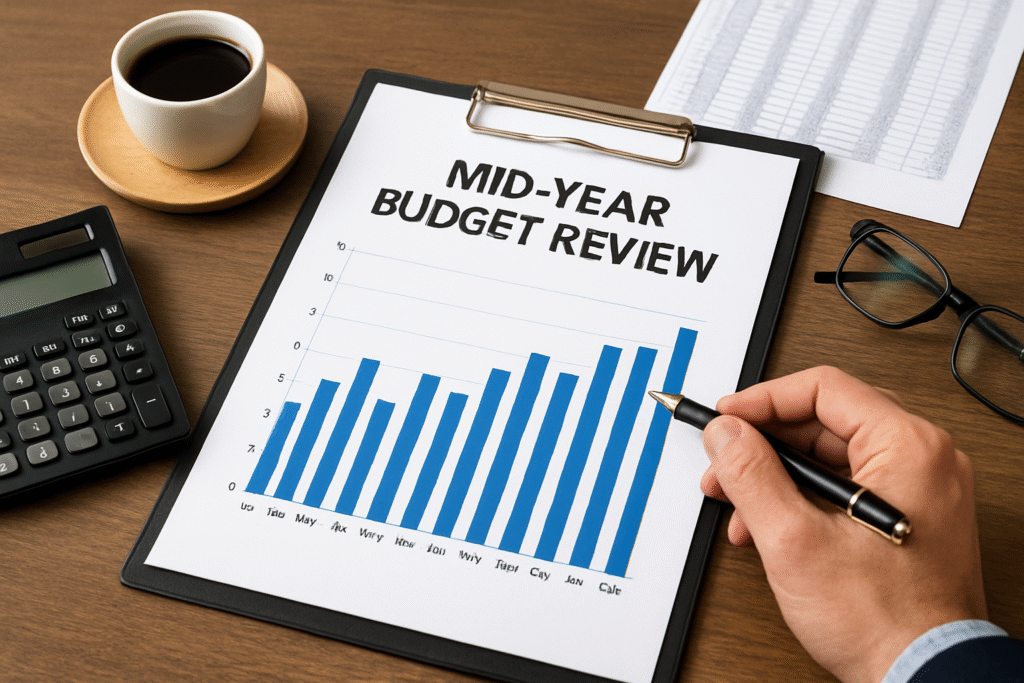Midyear Budget Review: How Does It Work in the US?
Learn how the Mid-Year Budget Review works in the US, the budget review process that assesses revenue and expenditures.
Understand the Midyear Budget Review in the US?

A mid-year budget review is a critical checkpoint in the financial planning process of governments and organizations alike. In the United States, this review serves as a strategic tool to assess, adjust, and align fiscal priorities based on actual economic conditions, revenue performance, and evolving policy needs.
Understanding how this process works provides valuable insight into how federal, state, and local governments remain responsive and accountable throughout the fiscal year.
The Purpose of the Midyear Budget Review
The primary objective of a mid-year budget review is to evaluate how closely actual revenues and expenditures align with the projections set out at the beginning of the fiscal year. Budgets are, by nature, predictive documents.
They rely on forecasts of tax income, economic trends, and anticipated spending. Midway through the year, governments must pause to reassess these assumptions in light of real data.
This process helps to identify significant variances, both positive and negative, and prompts timely adjustments to avoid overspending, underfunding of key programs, or fiscal imbalances.
It also allows agencies to re-prioritize funding or introduce new initiatives in response to changing circumstances, such as natural disasters, public health concerns, or economic downturns.
Who Conducts the Review?
At the federal level, the Office of Management and Budget (OMB) plays a central role in reviewing and reporting on the status of the national budget. The OMB collaborates with federal agencies to analyze spending patterns, revenue collections, and program effectiveness.
The results are typically summarized in the Mid-Session Review, an annual report released around July or August, which updates the President’s budget estimates based on current economic conditions and legislative changes.
State and local governments follow a similar pattern, though the structure may vary. Most states have a budget office or department of finance that works with governors and legislatures to monitor budget performance.
These offices gather fiscal data from agencies, compare it with budgeted amounts, and provide recommendations for action if changes are necessary.
Key Elements Assessed in the Review
The mid-year budget review focuses on several key areas. First is revenue performance. Analysts compare actual tax collections, such as income tax, sales tax, or corporate tax, with initial projections.
A surplus may indicate stronger-than-expected economic performance, while a shortfall might suggest a slowing economy or tax compliance issues.
Second is expenditure tracking. Budget offices assess whether departments and agencies are spending within their allocated budgets. Overruns in one area may require reallocation of funds from others or may trigger spending freezes or cuts.
A third major element is the macroeconomic outlook. The review considers new economic forecasts related to GDP growth, inflation, unemployment, and interest rates.
These projections are crucial for evaluating future budget risks and guiding mid-course corrections.
Adjustments and Policy Revisions
If the mid-year review reveals major deviations from the original budget plan, governments may implement corrective measures. These can include:
- Modifying discretionary spending levels;
- Freezing new hires or non-essential purchases;
- Reallocating funds between programs;
- Introducing mid-year supplemental budgets or emergency appropriations.
In some cases, especially at the state or local level, budget shortfalls may require drawing from rainy-day funds or passing legislation to revise the annual budget. Conversely, a surplus might be used to pay down debt, invest in capital projects, or provide tax relief.
Transparency and Accountability
Mid-year budget reviews enhance transparency in public finance by providing stakeholders, including legislators, the public, and credit rating agencies, with a realistic snapshot of the government’s fiscal position.
Reports generated during the review often become public records, fostering trust and enabling informed debate about fiscal priorities.
For example, many states publish detailed mid-year budget updates on their official websites, highlighting current balances, revenue changes, and proposed adjustments.
These updates not only help hold public officials accountable but also assist policymakers in making data-driven decisions for the remainder of the year.
The Role of Technology and Data
In recent years, technological advancements have played a growing role in streamlining the budget review process. Integrated financial management systems allow real time monitoring of revenue and spending data, improving accuracy and timeliness.
Advanced analytics and forecasting models help budget offices anticipate potential issues earlier in the fiscal year, allowing for proactive management rather than reactive measures.
Moreover, public finance dashboards and open-data portals are becoming more common, offering citizens a clearer view of how funds are being used and where changes are being made.
Conclusion
The mid-year budget review is a vital part of financial governance in the US, enabling governments at all levels to stay agile and responsible in the face of economic shifts and emerging challenges.
By evaluating actual performance against projections, reassessing economic assumptions, and making necessary adjustments, policymakers ensure that budgets remain realistic, effective, and aligned with public needs.
While the process may vary between federal, state, and local governments, the core principles, transparency, fiscal discipline, and adaptability, remain the same.
In an ever-changing economic landscape, the mid-year budget review is not just a technical procedure; it is a strategic necessity.





